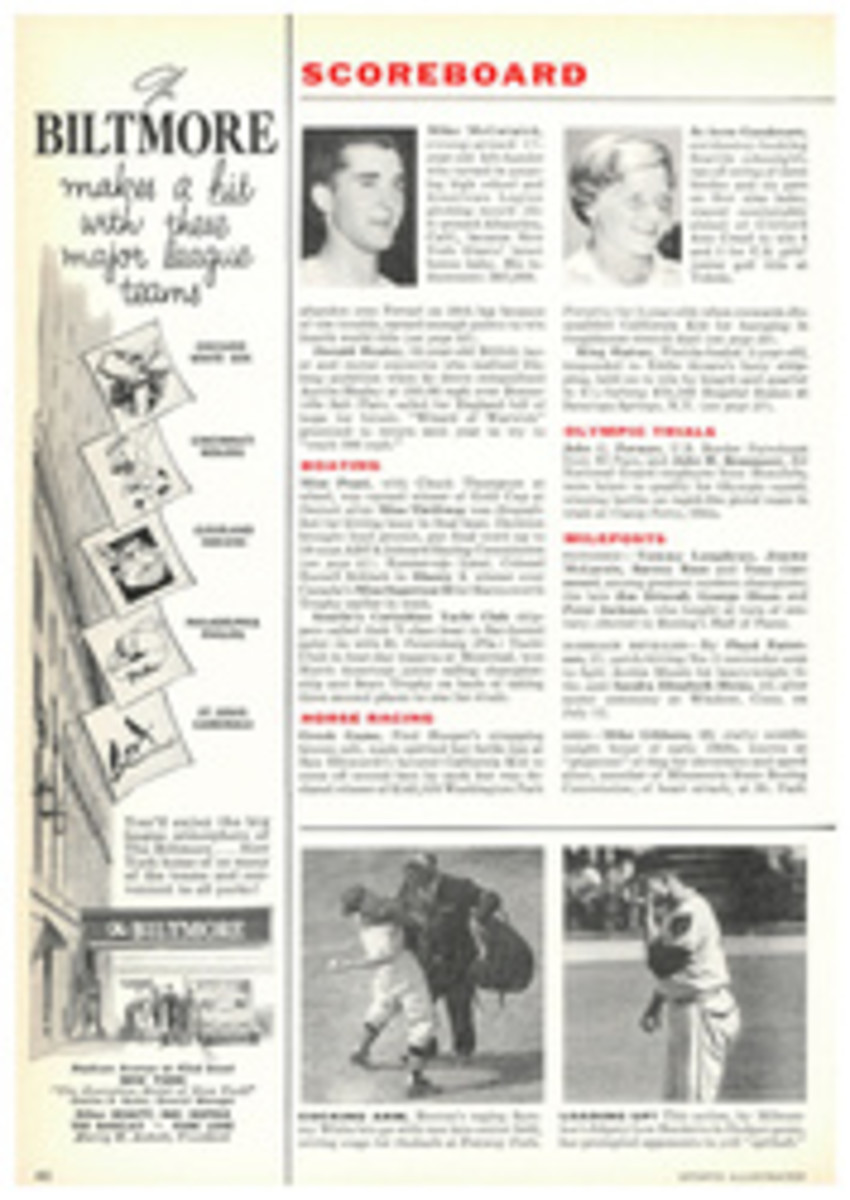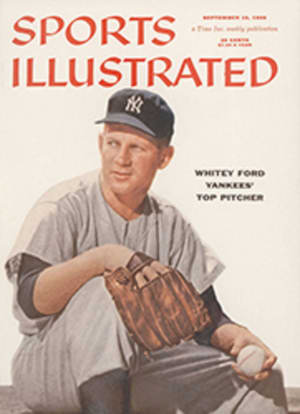
Stirling Moss won the race, but at stake also was a world driver championship, and Monza produced a FOURTH FOR FANGIO
MONZA, ITALY
By race time the cold fingers of fog which had probed through the north Italian night had lifted, the slicing rain had stopped and the track at Monza was dry, cool and fast. Through these ideal racing conditions Britain's Stirling Moss piloted a flashing redesigned six-cylinder Maserati to victory in the 17th Grand Prix of Europe. Roaring in six seconds behind Moss was Juan Manuel Fangio, driving an eight-cylinder Ferrari. Under a complicated all-season scoring system, second place in this Grand Prix at Monza assured the 45-year-old Argentine of his fourth world championship. "Troppo forte," say the Italians ruefully about Fangio.
Juan Manuel Fangio is a small-chinned, beak-nosed little man who looks somehow disappointing—until that moment when he puts on his helmet. Precisely then, an enormous calm seems to descend on him. His icily sharp blue eyes sweep the track in keen assessment.
Before the race chief interest centered on Fangio and his Ferrari. For three days all of the Ferrari engineering skills were concentrated on bringing these low-slung red racers to a peak of perfect performance. Moving with swift order through the crowded pits, Ferrari mechanics acted speedily to change the huge Englebert tires, to make engine adjustments, to check suspensions and transmissions. Of the seven Grand Prix races held this year, the Ferrari stable had won five and was looking for its sixth victory and a scintillating finish to the season. Already in the bag was the world championship for sports-racing cars, which brought Ferrari $85,000 in prize money.
In the pits, carefully watching the mechanics and testing cars on the elevated curves of Monza—banked so high that a man cannot crawl up them—were some of the finest drivers in the world. Second to Fangio in standings for the world championship before the race was Peter Collins, son of a British automobile dealer. Waiting for his turn at the time trials, Collins joked amiably with mechanics in the pits. Speaking with easy fluency in French and Italian as well as English, he looked like a relaxed kid between the halves of a high school basketball game. Then an Italian mechanic pointed a finger at him and said, "Campione del mondo (world champion)." Collins smiled, shook his head and nodded genially toward Fangio. He showed his nervousness only occasionally by chewing on a slender finger.
CAN'T SLOW UP
In sharp contrast to the personality of Collins was that of his stablemate Eugenio Castellotti, wealthy young Italian idolized as "Il Bello (the beautiful one)" throughout Italy and particularly worshiped here at Monza because he was both a home town boy and the best Italian prospect. "His great defect," said one expert in appraisal, "is that he doesn't know how. to slow up." Castellotti strutted proudly through the pits, cockily displaying his slim-hipped build. Before the race he called with annoying arrogance for "an all-Italian victory." Still, this handsome high-riding young man with the tight yellow T shirt was to Italian journalists "a good boy—as good as bread." And he was the only driver in the Ferrari stable to race with a small medallion of the Madonna riveted to the instrument panel of his car. Here at Monza during practice last year Castellotti turned his car over to his friend and master, Alberto Ascari, then watched with horror when Ascari turned over and was killed on the Serraglio curve.
Also driving a Ferrari but due to go out early in the race with the tire trouble which dogged the Ferraris the whole afternoon was the Spanish nobleman Marquis Alfonso de Portago. Always with Portago was his wife, a beautiful young American girl who remained incredibly immaculate in the grease, sweat and deafening roar of the pits. There was the ruggedly handsome Roman Luigi Musso, who stayed with the leaders for two-thirds of the race but finally limped painfully away from his car when the steering failed. Behind the wheel of a hump-backed Van-wall was the lean American Harry Schell. Schell was to become the most dramatic figure of the race when, after holding the lead madly in the early stages, he was forced to step oil-soaked from his disabled car and streaked with filth walk the long walk back to his pits and defeat. Along with Moss driving a Maserati was Piero Taruffi, experienced old fox of racing. And of course there was Moss, the winner that afternoon, a little man with curly hair and British good looks. The son of a prosperous pig breeder, Moss also jumps horses and is the foremost exponent of the lead-foot school of racing drivers. With his Maserati holding up superbly, those tactics were good enough to win for him.
Other entries included the small British engineering firm, Connaught, which displayed unexpected strength, the French Gordini, a persistent but habitually unsuccessful contestant and a sprinkling of private competitors.
When the mechanics shoved the big cars out on the track a pushing crowd of reporters and photographers jammed around Fangio and his Ferrari. Time trials had established him the heavy favorite when he broke the course record by averaging 137.5 mph for a single lap, tearing over the long looping country leg and the shorter banked oval leg which together constitute Monza's 6-mile lap. Second and third places in time trials were also won by Ferraris, and when the starter's flag snapped down it was the Ferraris, with a great drumming roar, which went into the lead. But it was not to be their race.
Recklessly driving his Vanwall, Harry Schell took an early lead and had his magnificent moment before breaking down. Burning around with dash and courage, Castellotti then careened into the lead but was forced to stop for a tire change when his wild acceleration flung burning bits of rubber from his rear tires bouncing crazily on the track. Shortly after, trying to make up for the precious seconds he had lost, II Bello drove off the track and was out of the competition. During the first third of the race the cold-blooded Fangio stalked the leaders, waiting for his opening. But it never came. When Castellotti retired Moss snatched the lead and never relinquished it. He drove his Maserati beautifully, capitalizing fully on the new design which set the steering wheel slightly to the driver's left, making Monza's right-hand curves easier. When Fangio's Ferrari, hampered first by tire trouble, was held up for motor adjustments, only a troublesome delay or a crash could have stopped Moss. And Moss had no intention of allowing either of those things to happen. He gave the crowd its greatest thrill when, just a few seconds in the lead, he pulled up to the pits on the 48th lap for his lone stop, only a few miles from the finish. But he was there a mere instant to refuel, and then he roared away again with unbelievable acceleration. All that remained for Moss were the flowers, the kiss, and the cup. Along with them came second place in the world championship standings and the establishment of new course records for the 310-mile race (129.7 mph) and for the fastest lap in competition (135.3 mph).
TEAM FIRST
Out with engine trouble, Fangio watched his teammate Collins, the man who had a theoretical chance of taking the world championship from him, circling the track. Despite occasional tire trouble Collins for 36 laps stayed within striking distance of the leaders. Victory for him, with Fangio side-lined, could have meant the championship he had been so modest about in the pits the day before. But it is international racing practice that the team, not the individual driver, must have precedence. In the Ferrari pits the decision was made that only Fangio could possibly have a chance to overtake Moss. So on the 36th lap out flashed the Ferrari red flag with the black rampant horse embossed upon it. Collins pulled up obediently at the pits. For an instant of emotion he embraced Fangio, clapped his back and helped him into the roaring car. Watching, Collins saw Fangio take over the wheel of his car and whirl off with his championship hopes. If he objected he never said so.
And so they finished—Moss a superb winner, driving the entire grind without a trace of mechanical trouble and moving into second place on the final championship rankings, and Fangio a remorseless harrier, beaten by a scant six seconds. The Connaughts were a surprisingly strong third and fifth, and Maserati rounded out a rewarding day by clinching fourth.
It was Moss's race, but Fangio's year. As Moss says, and nearly everyone else agrees, Fangio is the best.
[originallink:10470731:42144]
MAP
MONZA RACE COURSE, one of the world's fastest, utilizes a boomerang-shaped road circuit for first lee of each 6-mile lap, high-banked oval concrete track for the second.
START AND FINISH
GRAND CURVE
IESMO CURVE
VIALONE CURVE
NORTH CURVE
SOUTH CURVE
N

